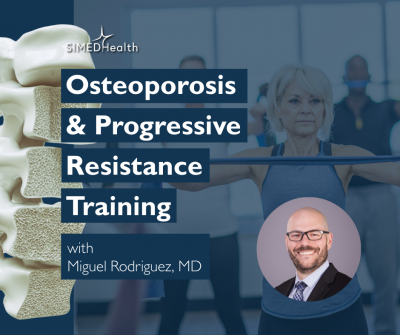
Progressive Resistance Training for Osteoporosis
1. What is progressive resistance training (PRT)?
With progressive resistance training one gradually increases the amount of weight used during strength training routines over a period of time. Applying gentle, progressive stress via resistance training signals your body to build stronger bones and muscles. PRT does not mean just lifting the same weighs day in and day out; it also includes gradually increasing the amount of weight you are lifting or increasing the amount of repetitions in a given lift. This stimulates mechanical stress on muscles and bones leading to increased muscle and bone strength.
2. How does PRT benefit individuals with osteoporosis?
Essentially, strong muscles lead to strong bones.
Progressive resistance training is an evidence-based exercise approach to improve bone density in people with osteoporosis. It also improves muscle strength, enhances balance, and reduces risk of falls, all leading to reduced fractures. It is offered at many physical therapy locations, including SIMEDHealth Physical Therapy and is covered by certain insurances.
PRT should be part of a comprehensive treatment plan for all patients with osteoporosis.
3. What types of PRT exercises are commonly used for osteoporosis?
Effective PRT exercises for osteoporosis include squats, lunges, leg presses, chest presses, weighted carries and rows. These exercises can be performed using free weights, resistance bands, or exercise machines. A weighted vest is gaining popularity as a low-impact tool for building bone strength and are a great way to add resistance to daily activities like walking your pet or doing chores around the house.
No matter what exercises one chooses it is importance to start light and progress gradually.
4. How often should someone with osteoporosis perform PRT?
The 2020 guidelines from the national osteoporosis foundation suggest performing progressive resistance training 2-3 times per week on non-consecutive days.
5. Are there safety issues associated with PRT for people with osteoporosis?
Yes, PRT is safe when performed correctly under supervision.
One of the issues with strength training exercises is that there is a learning curve for preforming them correctly. If performed incorrectly one can get hurt lifting weights, whether they have osteoporosis or not. This is why working with a knowledgeable physical therapist is of value. Do not think of going to physical therapy just to preform exercises at a location, but going to physical therapy is really to learn how to perform the exercises correctly. Programs designed with attention to proper technique, avoidance of high-risk movements (e.g., spinal flexion), with progressive components can be safely implemented for individuals with osteoporosis. Of course, it is important to discuss your exercise care plan with your treating physician.